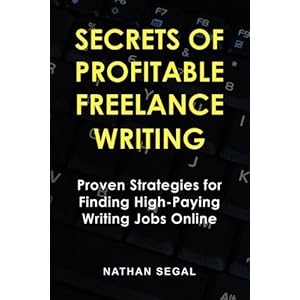Nathan Segal didn’t become a freelance writer by design, but rather by a combination of accident and necessity.
Thirteen years ago, he moved from one city to another to take a job as a software instructor at a technical school. Only things didn’t work out for him. He got into a tangle with the students and the administrator and got fired. He found himself unemployed in a strange city. That’s when fate smiled on him. His cousin, who was working as a freelance writer, came to visit and offered to teach him the trade. He survived and thrived.
Now looking back on years of writing he has decided to share what he learned so that others can enjoy the craft of writing and getting paid for it no matter where they are located.
His new book Secrets of Profitable Freelance Writing offers up numerous tactics, resources and lessons learned. In particular, he focuses on making precise and even free use of the tools that are available on the Internet.
Nathan believes that you can write about anything and get paid, even if you’re not an expert on the subject. The way you do this is by a combination of interviewing and research.
“Freelance writing has given me a lot of flexibility over the years, of time, location and travel,” he says. “Writing funds my travel adventures. It can do the same for you once you learn how.”
Here are some of the many useful ideas and strategies contained in his book:
1. To quickly show your interests and knowledge in one place, create a mind map, which is a circle with your name in it. Draw out a bunch of radiating lines. Each line represents and interest. Write down whatever comes to mind. Use these as writing topics.
2. To establish credibility quickly, write a few articles for web sites such as Demand Studios or Examiner.com. Use those clips to get better assignments.
3. To identify magazine listings and key contacts, get a free pass at the New York Public Library and make use of the Gale's Directories, which you can access here: http://www.nypl.org/
4. Find freelance magazine writing opportunities at: http://www.freelancewriting.
5. Establish a track record quickly by writing profiles (interviewing people) or book reviews.
6. Create content fast by interviewing an expert at helpareporter.com (HARO).
7. If you need software and can’t afford it, write a review for a magazine. You get the software and get paid.
8. Create great screen shots for your writing with Snagit, by Techsmith.
9. When pitching an editor, write three short summaries of the topics you have in mind. This increases your chance of winning an assignment.
10. Never write articles in advance of a submission. If the editor doesn’t like it you’ve wasted your time.
This step-by-step guide to freelance writing teaches how to find high-paying magazines and journals online and earn top dollar for the articles you write. Nathan Segal explains how to write great copy using little known techniques, how to quickly find and interview experts for your articles, how to write a flexible, scalable query letter which can be used for any writing proposal, big or small and how to use joint venture partnerships to maintain and increase your income.
About the Author
Nathan Segal has been working as a Freelance Writer for 13 years. In that time he has written 527 articles and five books. His articles have been published in many popular magazines, including: CE Tips (Consumer Electronics), Computer Graphics World, Database Journal, Mac Design, Photoshop User, Rangefinder, Smart Computing, The Computer Paper, Streaming Media World and Windows Expert. He worked as an Associate Editor at WebReference.com for 5 years. He also wrote several feature columns on 3D and video tutorials. He was the sole columnist at StreamingMediaWorld.com and wrote 116 articles in a 16 month period. He has written four other books: The Photoshop Companion, How to Speed Up Your Computer: In 30 Minutes or Less, Professional Photographic MS Word Templates and The Corel Photo-Paint X4 Insider.
My Take on the Book
I have been writing for some time, but most of this writing has been done personally instead of professionally. This book, though short, was full of so many resources for the would-be freelance writer. I was amazed at how easy this book was to read and understand. I also was impressed at how much could be placed into one book. This little book was a ready reference guide for all writers, and it was one that I will definitely keep around to assist me in the future as I continue to write and possibly look to writing professionally in the future as well.
If you would like to have this book for your own collection you can find it on Amazon!
All opinions expressed in this review are my own and not influenced in any way by the company. Any product claim, statistic, quote or other representation about a product or service should be verified with the manufacturer or provider. Please refer to this site's Terms of Use for more information. I have been compensated or given a product free of charge, but that does not impact my views or opinions.

-------------------------------------------------------------------------------------------
New to the Divadom?
Please Subscribe to my RSS Feed! Subscribe in a reader
Questions?Drop me a line at dadofdivas@gmail.com

No comments:
Post a Comment